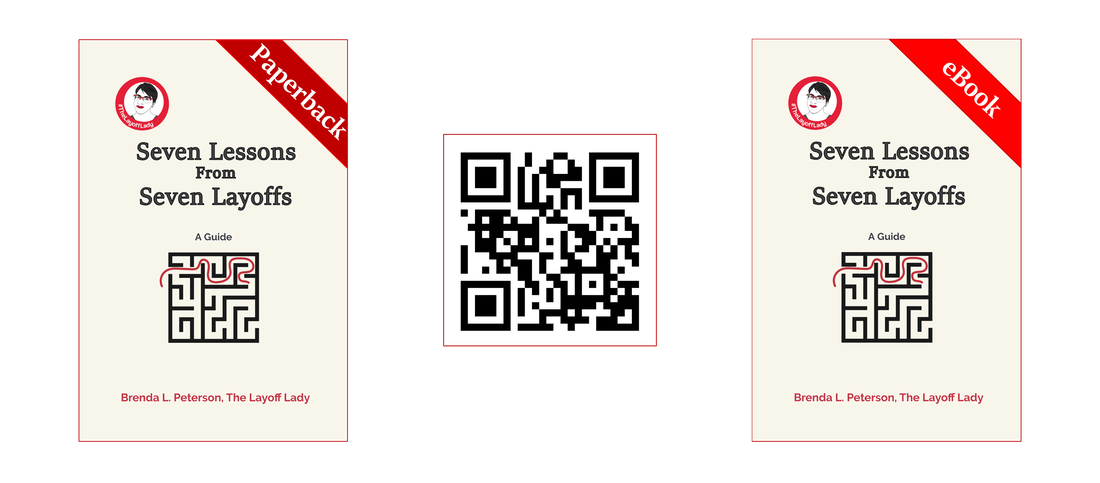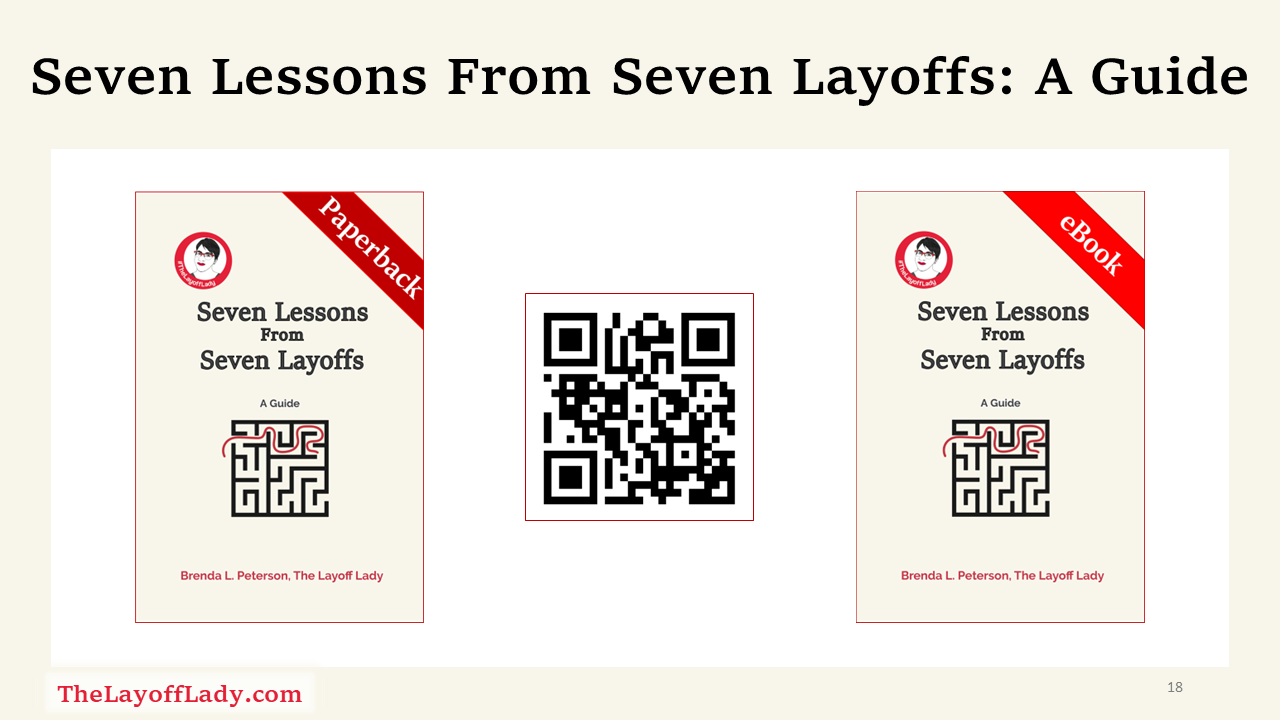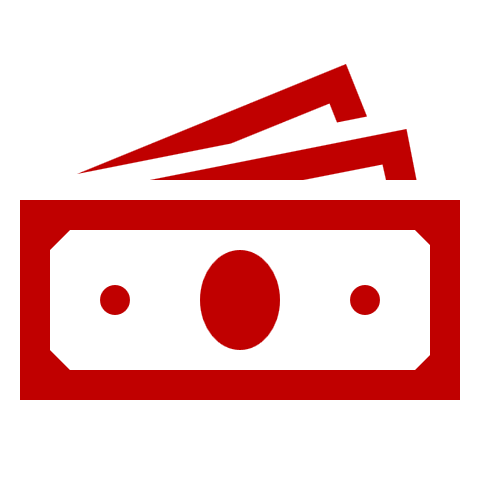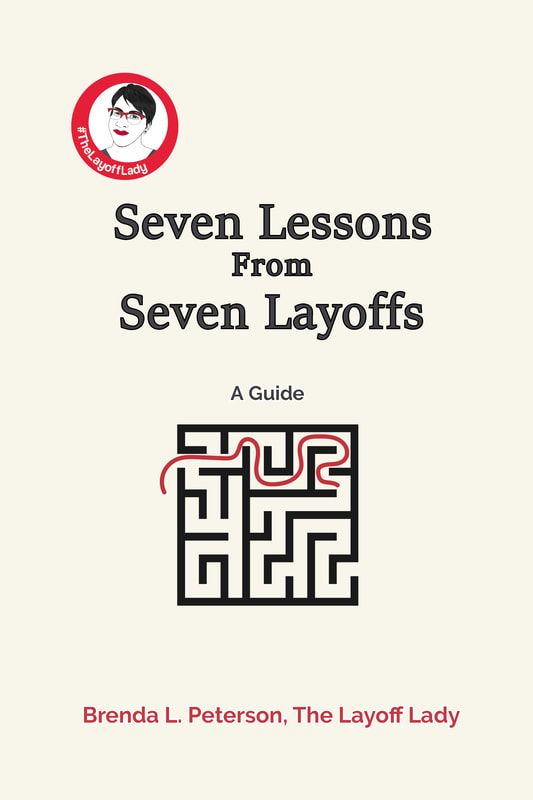|
By Brenda L. Peterson, The Layoff Lady About The Seven Layoff LessonsThrough my seven layoffs and many conversations with others in post-layoff career transition, I have learned seven core lessons:
About Layoff Lesson Seven: Assess, Adapt, and Rise AboveWhen you’re searching for a new job, there are always challenges. Like with any system you put in place to solve a problem, it’s helpful to compare the actions you’ve been taking to your results. It's valuable to review where you are getting stuck during the hiring process and updating what you're doing so you can see more success. Let's look at some of the challenges you might face. Interview Progression IssuesAfter you apply for a job, your goal is to be selected for an interview. That process usually includes an initial phone screen, one or more face-to-face interviews, and then a job offer. Let’s look at possible places you might get stuck and how to evolve your approach.
Additional Job Search ChallengesEven when you have good results with your overall job search and hear back from companies on specific roles, you’ll still face challenges. Let’s look at a few:
You are the CEO of YouAt the end of the day, remember your role as the CEO of You and make a decision that aligns with your overall career and life goals. That might mean adjusting your requirements as your search goes on or holding out for what you really want. You get to decide what matters most to you and change your mind as needed. For The Whole StoryFor all the information on each of the seven lessons pick up a copy of my book Seven Lessons From Seven Layoffs: A Guide. Learn More
0 Comments
By Brenda L. Peterson, The Layoff Lady About The Seven Layoff LessonsThrough my seven layoffs and many conversations with others in post-layoff career transition, I have learned seven core lessons:
About Layoff Lesson Six: Examine Your Energy to Take Control of Your TimeEven when you have a general idea of what needs to happen, sometimes it’s hard to translate higher-level information into specific activities. Sometimes, even when you have a clear sense of your goals and a well-written to-do list, another obstacle remains. Even when you know what your top priorities should be and how urgent those tasks are, you still can't manage to get those crucial things done. How is that even possible? In short, it all comes down to our energy. When life is puttering along as planned, we don’t have to spend undue effort living our everyday lives. Post-layoff, a lot changes. Losing your job upends your life and gives you a whole new set of challenges you simply have to figure out. These problems also come with uncertainty about the future, new complexities in your financial life, and anxiety about how long it might take to get back to something that could be called normal. You are now entering an unplanned phase in your life where you will experience more rejection in a shorter period of time than ever before. All of this change and rejection can take its toll. Managing Your MindsetBe sure to leverage your Realistic Optimist mindset by reminding yourself that good things are coming—as long as you put the work in to get there. While you can accomplish a lot, you’ll never be able to do absolutely everything that may contribute to your success. Instead of setting unrealistic expectations for your ongoing productivity, you need to prioritize where you spend your energy and your time. Leading and Lagging IndicatorsWhen pursuing a big goal, it's important to focus on taking the small steps that will help you achieve your larger goal. Many times, we think of the end goal--for example, an accepted job offer is one of the ultimate measures of job search success. Having a new job is a lagging indicator. That means that it is a big goal that won’t happen for a while and has many contributing factors. Too often, people overfocus on achieving a big goal (lose 50 pounds, write a book, run a marathon) but skip over the smaller steps that build toward that huge goal. This is where leading indicators come in. Leading indicators are all of the tasks you need to complete to position yourself to achieve that bigger goal. Leading indicators are those smaller, checkoffable things you can control. For job searching, those might be applying for three jobs a week, sending LinkedIn connection requests for two people per week, and sending thank you notes after an interview. Consistently doing those leading indicators will help you achieve those lagging indicators. All Hours Are Not Equally ProductiveWhen I’m in career transition, I spend a lot of time writing, applying for jobs, and interacting on LinkedIn. I also tend to rewatch TV shows and movies. Conventional time management would say that I’m wasting a good chunk of my life. In reality, it is not feasible to produce noteworthy results all the time. Achieving at a high level requires preparation and adequate recovery time. That means if I have two video interviews in one day, I will appear to be doing nothing for those couple of hours right afterward. The only way I can knock those interviews out of the park is by managing my energy well. Reflect on Factors Influencing Your EnergyAs you think about how to spend your time, learn about yourself and when you will be the most productive and happiest with each activity. I interact with LinkedIn posts during my first cup of coffee, enjoy afternoon walks, and do yoga at night before bed. There are no absolute right or wrong times for most things, just ones that are a better fit for you. Take time to reflect on your most and least productive times of day. Do you excel in the morning, or do your best work late at night? How much structured time do you need? How much social time do you need? These answers will help you gain a sense of how to get the most out of each day. Energy Builders and PrioritizationPlain and simple, there is not enough time to do everything you could possibly do. Therefore, it’s crucial to prioritize your time. This helps ensure you are doing the highest value activities that get you closer to your goal. Know that saying yes to higher-value activities--like having a job interview or meeting with colleagues--means you’ll have to say no to other activities. If socializing drains you, you may skip a social gathering and rest to recover and prepare for other job-searching tasks. Also remember that energy builders, like resting, walking outdoors, or medication, can help you sustain the energy levels needed to work toward your goal for as long as it takes. For The Whole StoryFor all the information on each of the seven lessons, pick up a copy of my book Seven Lessons From Seven Layoffs: A Guide. Learn MoreBy Brenda L. Peterson, The Layoff Lady About The Seven Layoff LessonsThrough my seven layoffs and many conversations with others in post-layoff career transition, I have learned seven core lessons:
About Layoff Lesson Five: Help People Help YouLife is challenging when nothing out-of-the-ordinary is happening. It's even harder when you're going through an unexpected job change. While I'm a fan of self-reliance, I also know how important it is to find your people and support one another as you go through challenges. You're not weak for needing people. You are strong because you know the value of building and leveraging relationships to help get you through trying times. I have found that people genuinely want to help. In many cases, though, they might not know what you need. Not only is it vital that you seek out help when you need it, but you need to figure out what type of help you need. One Career Transition RevelationHere's something that might surprise you. When you tell people that you're looking for a new job, this is when you will discover that many people don’t know exactly what it is you do for a living. Instead of being taken aback that they don’t know, use this as an opportunity to learn how to tell them what you want and need during your career transition--and it's much more than just a new paying job. Figure Out What Life Help You NeedFirst off, you need to figure the types of life help you might need:
Figure Out What Job Search Help You NeedIn addition, you need to figure the types of job search help you might need:
It Takes a VillageOnce you have a better idea of what you need, make sure you don't expect one person to fill all of these roles. Think about who could help you in each area and reach out to them. Leveraging Your Professional NetworkLinkedIn is my goto tool for building and managing my professional network. It's importan to make sure your LinkedIn profile represents you well, and that you showcase your experience and the value you bring to others, and to a new role. There is also an art (and a process) to asking people in your professional network in a way that is mutually beneficial. For The Whole StoryFor all the information on each of the seven lessons pick up a copy of my book Seven Lessons From Seven Layoffs: A Guide. Learn MoreBy Brenda L. Peterson, The Layoff Lady About The Seven Layoff LessonsThrough my seven layoffs and many conversations with others in post-layoff career transition, I have learned seven core lessons:
About Layoff Lesson Four: Shape and Share Your StoryNow that you’ve determined what you want in your next role, your new challenge is learning to tell your story. This includes telling the overall story of who you are professionally and the value you bring. To this end, you'll use a few key documents to summarize what you do, highlight your core accomplishments, and persuade that employer that they should spend more time learning about you. Your Job Search ToolkitYour job search toolkit is the collection of information you need to showcase your value to a potential employer. Each item in this list helps you share a part of your story during the hiring process.
Your What I Want StatementBased on what you learned during your Structured Soul Searching, the next step is writing a clear and concise “What I Want Statement." This statement can help you as you review job openings and prioritize your applications to those that most closely align with your goals. This statement can also be repurposed when letting other people know what jobs interest you the most. Your Professional SummaryIn addition to your “What I Want” statement, you also need to be able to tell your career story. Your professional summary is that paragraph of quick-hit information that starts to outline who you are, your qualifications, and what you bring to the table as a candidate. This statement can also be repurposed when letting other people know what jobs interest you the most. Your Interview AnswersThe same stories you use in your resume to showcase your skills and the results they generate can also become the answer to commonly asked interview questions. Instead of answering with no plan and hoping for the best, you can use a model, like CARL or STAR, to structure your answers and get to your point more quickly. For The Whole StoryFor all the information on each of the seven lessons pick up a copy of my book Seven Lessons From Seven Layoffs: A Guide. Learn MoreBy Brenda L. Peterson, The Layoff Lady About The Seven Layoff LessonsThrough my seven layoffs and many conversations with others in post-layoff career transition, I have learned seven core lessons:
About Layoff Lesson Three: Ask Yourself, “What do I want to be next?”Few people take the time to step back from their work life and think, “Is this really what I want to do?” When you go through an unplanned job change, seize this rare opportunity to revisit your career path. Take time for a little structured soul searching and actively decide what you want both long-term and in your next job. An Opportunity For Self ReflectionWhile it’s hard to take the time to reflect when you’re busy living your life, a layoff means the pause button has just been pushed on your career. This may be your once-in-a-lifetime chance to reassess your current situation and think about what you really want from your work life. What Do You Want To Be?Adults often ask children, "What do you want to be when you grow up?" As an adult, especially in a time of transition, it's valuable to pause and ask yourself that question once again. Once that good enough job is no more, its an excellent time to dedicate some time to figuring out your longer-term career goals. After you identify what you'd like to ultimately do, it's valuable to answer the question, "What do I want to do next?" Being able to describe the details of your desired next job will help you find the next right role for you. Structured Soul SearchingThe structured soul-searching process involves reflecting on many areas of your life, including what truly matters to you, your natural ways of working, your skills, and your interests. This process includes identifying your personal values, finding out and naming your strengths, gathering information on what you like to do at work, and identifying your desired salary. This process will include connecting with previous coworkers to discuss their observations, reviewing job descriptions for skills that appeal to you, researching compensation information, taking online assessments, and making time for personal reflection. This process will help you establish what type of new role would be the best fit for you at this point in time. Prioritizing What Matters To YouOnce you reflect in a few different ways, it’s time to gather what you’ve learned and use that to put together your preferences list for the job you want. You'll think through your preferences regarding work logistics, salary, benefits, employer characteristics, and the day-to-day job and determine what matters most to you. You can also revisit your target job profile and adjust it as your job search continues. As you move through your job search, you'll learn more about what you really want (and what you really don't want). You'll continue to fine-tune what the right next job for you is so you can focus your job search efforts accordingly. For The Whole StoryFor all the information on each of the seven lessons pick up a copy of my book Seven Lessons From Seven Layoffs: A Guide. Learn MoreBy Brenda L. Peterson, The Layoff Lady About The Seven Layoff LessonsThrough my seven layoffs and many conversations with others in post-layoff career transition, I have learned seven core lessons:
About Lesson Two: Keep Your Mind on Your Money (and your money on your mind).Most people work to pay their bills and afford the life they want. Unfortunately, when your job ends, so does your main income stream—and possibly your health insurance, too. Making the right short-term changes can help you weather the storm while also minimizing long-term financial repercussions. Let’s look at a few key components of this lesson. Post-Layoff ChangesAfter a layoff, many things in your financial life change. Now, you don’t know when your next paycheck will arrive or how much it might be. However, you do know that you need to figure out how to survive financially from now until that unknown future date. As you wrestle with uncertainty, you need to research options, run the numbers, and make the right decision for your household. New Financial GoalsNext, it’s important to adopt new interim financial goals. Now, the focus is not on getting ahead or progressing toward larger goals. Instead, your overarching goal is to live through your period of unemployment until you are gainfully employed again with as little long-term financial trauma as possible. Career Transition Income SourcesWith your day job gone, chances are your core source of income just evaporated. Instead, you’ll get one last paycheck. Your check may be a little larger than usual if you get a vacation payout and a little bigger still if they don’t deduct anything for the benefits you won’t have anymore. Depending on your situation, you might also get a severance payment—which could be any amount between a fat lot of nothing and the equivalent of several months of income. In most cases, when your job ends due to a layoff, you will be eligible for unemployment insurance (UI) benefits. UI replaces a portion of your employed income—which will most likely be significantly less than your previous paycheck. There are multiple ways to help fund your life varying from good to decidedly bad ideas. These could include using your savings, taking on short-term work, or incurring additional debt. Career Transition HealthcareWhile you’re working, your health insurance has a pretty good chance of being connected to your day job, and your employer may even pay a portion of your costs. When your job ends, you have a lot of decisions to make. You can continue your current health care coverage with a significantly higher cost, usually referred to as COBRA. If possible, you could become a dependent on someone else’s coverage or find a plan on Healthcare.gov. Alternatively, you could enroll in a lower-cost short-term health plan or find other ways to pay for healthcare costs. When it comes down to it, it’s essential to consider the short and long-term implications of your healthcare decisions—especially since having an unexpected health expense can cause severe financial hardship. Career Transition ExpensesUnfortunately, while your regularly scheduled income goes away, your expenses generally do not. Now, it’s more a matter of adjusting your priorities and seeing what you can do to streamline your layoff survival budget. When times are tight, you will need to make more calculated decisions regarding where you spend money. Line items like rent, car payments, and utilities may be non-negotiable, while you may need to pare down what you spend on non-essential expenses like entertainment and restaurants. As you work to minimize expenses, this is another area where making shortsighted decisions can cause long-term problems. You also need to make sure you still take part in activities that make you happy, even with less discretionary income. When Income and Expenses Don't Line UpOne of the harsh realities of career transition is that your current income may be significantly lower than your outgo. In these cases, you may need to take on additional work or incur some debt. If you can’t pay your bills, contact the company and discuss options. While it can be humbling, it’s better than damaging your credit score, which can negatively impact your financial life for years to come. For The Whole StoryFor all the information on each of the seven lessons pick up a copy of my book Seven Lessons From Seven Layoffs: A Guide. Learn MoreBy Brenda L. Peterson, The Layoff Lady About The Seven Layoff LessonsThrough my seven layoffs and many conversations with others in post-layoff career transition, I have learned seven core lessons:
About Lesson One: Experience Your Emotions and Manage Your Mindset.Right after a layoff, people often act hastily out of sheer unbridled panic. Instead, you must attend to two key tasks right away: feeling your feelings and choosing your career transition mindset. Getting your head on straight before springing into action will prepare you for the challenges ahead. Let’s look at a few key components of this lesson. Experiencing Your Emotions Losing your job, even through no fault of your own, will bring on a myriad of feelings. When someone asks you how you are, you may say “fine,” and you may even think that you are, indeed, fine. In truth, you are pretty far from fine, and you may not be truly fine for a good long while. Right after a layoff, your mind will be spinning as you process what just happened and figure out what on earth to do with yourself next. Your dominant emotions may include shock, anger, sadness, fear, and possibly even relief. As your career transition continues, you’ll cycle through those emotions as you hit ups and downs. At every step of the way, you’ll also experience more people telling you no than at any other time in your life. Through all of these feelings, it’s important that you acknowledge each one, and work your way through them. Managing Your MindsetYour mindset is your overall approach to dealing with the world. It includes how you think about your current situation, including your assumptions about what is true. When people search for a new role, successful people believe that the future will be good while also acknowledging that there will be challenges along the way. Adopting a mindset that combines optimism and realism will help you weather the challenges you’ll face. Changing your language to support your updated mindset will help you stay motivated, no matter how long your search lasts. You Are The CEO of YouAlong with your mindset, it’s helpful to change how you think about work. Instead of thinking of yourself as an employee who has to do whatever their employer asks or else, you need to give yourself a life promotion. In reality, your career is your business, and you are the CEO of You. Just like the executive team at a company needs to make tough decisions for the organization’s greater good, you need to make business decisions that are in the best interests of you and your household. For The Whole StoryFor all the information on each of the seven lessons pick up a copy of my book Seven Lessons From Seven Layoffs: A Guide. Learn MoreBy Brenda L. Peterson, The Layoff Lady Why I Started The Layoff LadyI remember the good old days when I felt bad for my friend Tricia because she had been laid off four times. When I found myself working through my post-layoff career transition number seven, I decided I needed to do more than just find myself a new professional "day job." I also committed myself to documenting my lessons learned. I wanted to create resources that could benefit others who unexpectedly found themselves unemployed. Out of that decision, The Layoff Lady was born. I share my insights through blog articles, educational sessions, speaking engagements, podcast interviews, and my book Seven Lessons From Seven Layoffs: A Guide. I committed myself to sharing what I had learned to help people on who have been part of a layoff, who are in job transition, and people who want to proactively build their career resilience to help ensure their professional success. About The Seven Layoff LessonsThrough my seven layoffs and many conversations with others in post-layoff career transition, I have learned seven core lessons that can help you navigate this challenging time. If you are in the midst of a post-layoff career transition, these lessons speak directly to the unique challenges you will face as you navigate from layoff day until the first day of your new job. If you're currently employed, but aware that no one is immune to layoffs, these lessons can help you understand the layoff experience and plan ahead just in case it happens to you. Let's briefly review my seven lessons. In future blog articles, I'll expand on each lesson in more detail. Lesson One: Experience your emotions and manage your mindset.Right after a layoff, people often act hastily out of sheer unbridled panic. Instead, you must attend to two key tasks right away: feeling your feelings and choosing your career transition mindset. Getting your head on straight before springing into action will prepare you for the challenges ahead. Lesson Two: Keep your mind on your money (& your money on your mind).Most people work to pay their bills and afford the life they want. Unfortunately, when your job ends, so does your main income stream—and possibly your health insurance, too. Making the right short-term changes can help you weather the storm while also minimizing long-term financial repercussions. Lesson Three: Ask yourself, "What do I want to be next?"Few people take the time to step back from their work life and think, “Is this really what I want to do?” When you go through an unplanned job change, seize this rare opportunity to revisit your career path. Take time for a little structured soul searching and actively decide what you want both long-term and in your next job. Lesson Four: Shape and share your story. Finding a new job is all about you telling the story of your career. You get to shape your professional narrative so you can share your compelling story with colleagues and potential employers. Learning to talk about where you’ve been, your skillset, and where you’re going is powerful. Weaving in company needs with who you are professionally will help you communicate your value more effectively. Lesson Five: Help people help you.It’s hard for many of us to ask for help. If there was ever a time to avoid going it alone, this is it. Overall, people genuinely want to help others through trying times. You can assist them by being mindful of what you need and asking just the right person. Letting people help you will make managing the emotional, logistical, and practical aspects of this career transition easier. Lesson Six: Examine your energy to take control of your time.When it comes to achieving a goal, people often focus on time management. While checking the right items off a task list is valuable, having the energy to do so is often overlooked. Figuring out those right things to do, prioritizing tasks, and factoring in your energy levels will help you sustain your job search momentum for the long haul. Lesson Seven: Assess, adapt, and rise above.Having a plan for success is critical. It is even better to assess how it is going, adapt when needed, and rise above challenges. By anticipating roadblocks and thinking through possible solutions, you can proactively alter your game plan as needed. Learning as you go will help you build resilience and cultivate successful outcomes. For The Whole StoryFor all the information on each of the seven lessons pick up a copy of my book Seven Lessons From Seven Layoffs: A Guide. Learn More |

Just get laid off?
Click here for info on what to do first. Author7-time layoff survivor Brenda L. Peterson, The Layoff Lady, waxes poetic on layoffs, job transitions, & career resilience. Buy The Book!Were you recently laid off from your job and need a roadmap for what's next? Pick up a copy of my book, Seven Lessons From Seven Layoffs: A Guide!
Categories
All
Archives
July 2024
|
















